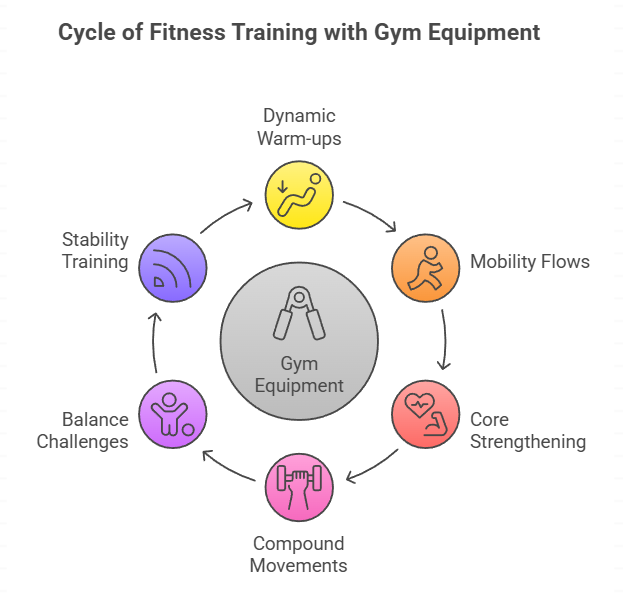
When it comes to functional fitness and injury prevention, the right equipment can make all the difference. One tool that continues to prove its value in home gyms and professional studios alike is the 75cm ball—a versatile, core-strengthening piece designed for balance training, rehab, and full-body workouts.
Whether you’re upgrading your current setup or outfitting your first gym space, knowing how to choose the right size, quality, and features in this category can elevate your training experience and results.
Why Size Matters in Stability Training
The first step in selecting the right gear is understanding who it’s for. This option is typically best suited for individuals over 6 feet tall. When used correctly, it allows for proper alignment during exercises like seated stretches, crunches, or planks. Sitting on it, your knees should bend at roughly 90 degrees with your thighs parallel to the floor—this is a good indicator that you’ve got the right size.
Incorrect sizing can lead to ineffective form or even increased strain on joints, particularly during back and core exercises. For tall users, anything smaller might compromise spinal posture or range of motion, especially during seated or prone movements.
Multi-Purpose Use: From Pilates to Powerlifting
Fitness professionals and athletes use gym equipment across a wide range of disciplines. Whether you’re doing dynamic warm-ups, mobility flows, or core strengthening circuits, this version can support compound movements, balance challenges, and stability training.

Here are just a few practical uses:
Physiotherapy: Great for rehab routines targeting lumbar support and spinal decompression
Strength Training: Combine with dumbbells for stability presses or glute bridges
Functional Training: Perfect for instability push-ups or leg curls
Stretching & Recovery: Provides controlled support for chest openers and backbends
One coach in Brisbane recently incorporated a stability model into his corporate wellness program, noting that even clients unfamiliar with fitness found it intuitive and effective. The simplicity helped introduce key movement principles in a low-risk, engaging way.
What to Look for in Quality and Durability
With so many variations on the market, it’s essential to choose a product that’s built to last, especially if it’s going to be used regularly or in a commercial setting.
Look for features like:
Anti-burst material: Prevents sudden collapse in case of puncture
Slip-resistant texture: Ensures safety during dynamic movement
Weight capacity rating: Should support at least 250–300kg for serious training
Pump and accessories: Some brands offer fast-inflate options or stabilising rings
Buyers have increasingly turned to reliable Australian suppliers like Xpeed Australia, which offer commercial-grade gear backed by strong warranties. Feedback from users frequently highlights how these maintain their shape over time and stand up to both indoor and outdoor use.
Who Should Use It?
While the 75cm size is ideal for taller users, it’s also a strong pick for certain training needs regardless of height:
Trainers working with athletes: The larger size offers more surface area for dynamic drills
Pregnant clients: Safe for prenatal stretching and pelvic floor activation when properly supervised
Posture-corrective programs: Offers elevated seated positions and greater range for thoracic movement
Desk workers: Can double as an ergonomic alternative to office chairs for core engagement
In Perth, a physiotherapist specializing in scoliosis rehab recommends the larger size for specific spinal extension drills, noting that the broader surface allows for safer support during regression exercises.
Home Gym vs. Commercial Studio Use
If you're buying for a home setup, think about space and storage. A 75cm option does take up a little more room than its smaller counterparts, but it’s worth it if you need more range of motion or are working with multiple clients.
In professional studios, having a few size options—including the larger version—ensures you can accommodate diverse client needs. Trainers often color-code or label their equipment to streamline sessions and reduce sizing mix-ups.
Many boutique gyms in Australia source their equipment from Xpeed Australia, as the products are known for their consistency in sizing, material strength, and easy-to-clean surface—critical in high-traffic environments. If you're based nearby, you can visit our South Australia location to view the range in person and get expert advice before purchasing.
How to Incorporate It into a Routine
If you’re unsure where to begin, try adding it to your current strength or mobility workouts. Some easy ways to start include:
Wall squats: Place the ball between your lower back and the wall for a controlled descent
Ball pass: Transfer between hands and feet during crunches for core activation
Hip lifts: Feet on the ball, raise your hips into a bridge, and challenge your glutes and hamstrings
Bird dog variation: Use it to create instability under the knees or hands for added balance work
Small business owners running online programs or YouTube fitness channels can also incorporate this tool into routines to create scalable, beginner-friendly content that looks professional and includes functional variety.
Storage and Maintenance Tips
Because of its larger size, make sure you have space to store it safely. Consider a mounted wall rack or corner stand if you’re tight on space. Avoid leaving it near heat sources or direct sunlight for prolonged periods, as this can weaken the material.
Wipe it down regularly with a gentle cleanser or disinfectant wipe—especially in shared spaces. Quality products, like those sold by Xpeed Australia, are designed to resist wear even with regular cleaning and use.
Sustainability and Longevity
Many consumers today are concerned with how long their purchases will last, not just in function but also in environmental impact. Higher-end models are now being manufactured using low-toxic, recyclable materials that align with sustainability goals.
A trend emerging among eco-conscious Australian buyers is choosing fewer, higher-quality items that serve multiple purposes—and the 75cm size fits this mold perfectly. It eliminates the need for extra back support tools or balance boards when used creatively.
Choosing the right size and build for your training tools makes a lasting difference in performance, posture, and injury prevention. A 75cm stability tool might seem like a simple purchase, but when selected with intention and used effectively, it becomes a cornerstone of mobility, core strength, and functional training.
Whether you're a seasoned trainer, a weekend warrior, or setting up your first gym space, investing in a high-quality option that supports your body and training style is a smart step toward long-term results. And when sourced from trusted suppliers that prioritize durability and performance, that investment pays off in more ways than one.


Write a comment ...